City of Gold Coast
The City of Gold Coast is the local government area spanning the Gold Coast, Queensland, Australia and surrounding areas. With a population of 606,774[1] it is the second most populous local government area in Australia (City of Brisbane being the largest).[1] Its council maintains a staff of over 2,500. It was established in 1948, but has existed in its present form since 2008.
| City of Gold Coast Queensland | |||||||||||||||
|---|---|---|---|---|---|---|---|---|---|---|---|---|---|---|---|
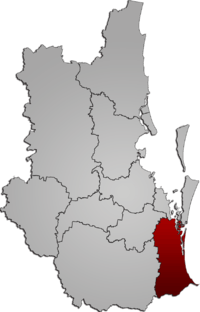 Map showing City of Gold Coast within South East Queensland | |||||||||||||||
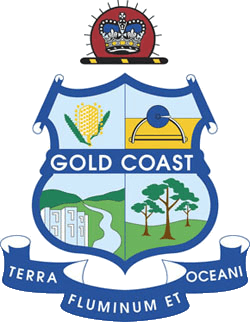 City of Gold Coast Coat of Arms | |||||||||||||||
| Population | 606,774 (2018)[1] (2nd) | ||||||||||||||
| • Density | 454.85/km2 (1,178.1/sq mi) | ||||||||||||||
| Established | 1948 | ||||||||||||||
| Area | 1,334 km2 (515.1 sq mi)[1] | ||||||||||||||
| Mayor | Tom Tate | ||||||||||||||
| Council seat | Surfers Paradise | ||||||||||||||
| Region | South East Queensland | ||||||||||||||
| State electorate(s) | Bonney, Broadwater, Burleigh, Coomera, Currumbin, Gaven, Mermaid Beach, Mudgeeraba, Southport, Surfers Paradise, Theodore | ||||||||||||||
| Federal Division(s) | Fadden, Forde, McPherson, Moncrieff, Wright | ||||||||||||||
 | |||||||||||||||
| Website | City of Gold Coast | ||||||||||||||
| |||||||||||||||
History
Early history
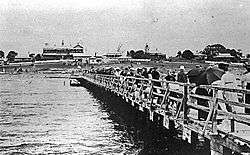
By the late 1870s, the Government of Queensland had become preoccupied with the idea of getting local residents to pay through rates for local services, which had become a massive cost to the colony and were undermaintained in many areas. The McIlwraith government initiated the Divisional Boards Act 1879 which created a system of elected divisional boards covering most of Queensland. It was assented by the Governor on 2 October 1879, and on 11 November 1879, the Governor gazetted a list of 74 divisions which would come into existence. Four of these — Nerang, Coomera, Beenleigh and Waterford — were in the Gold Coast region. Southport was developed as both an administrative centre as well as a holiday destination with hotels and guesthouses to cater for visitors. Town dwellers had different needs to the rural landholders so Southport ratepayers lobbied the colonial government to create a separate Divisional Board so that rates monies raised by Southport landholders could be spent on town improvements. This resulted in the establishment of the Southport Division on 14 July 1883 by an amalgamation of part of Nerang Division and part of Coomera Division.
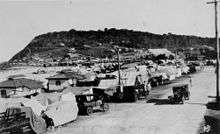
On 31 March 1903, following the enactment of the Local Authorities Act 1902, the divisions became shires. On 12 June 1914, the Town of Coolangatta was created from part of the Shire of Nerang, and on 12 April 1918, Southport became a town.[2]
Development and growth
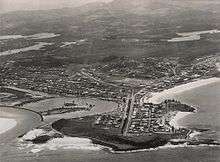
On 9 December 1948, as part of a major reorganisation of local government in South East Queensland, an Order in Council created the Town of South Coast by amalgamating Town of Southport, Town of Coolangatta and coastal sections (around Burleigh Heads) of the Shire of Nerang, creating a narrow coastal strip. The same Order abolished all of the earlier Shires and amalgamated most of their area into the new Shire of Albert, with the rest becoming part of the Shire of Beaudesert. The Order came into effect on 10 June 1949, when the first elections were held for the new councils.
On 23 October 1958, the Town of the South Coast adopted the name of Town of Gold Coast, and on 16 May 1959, the Town was proclaimed as the City of Gold Coast by the Governor of Queensland, having met the requirements for city status. Most of what is now regarded as the Gold Coast urban area was at that time located within the Shire of Albert, which had its administrative offices in Nerang-Southport Road, Nerang.
A regional authority
On 19 March 1992, the Electoral and Administrative Review Commission, created two years earlier, produced its report External Boundaries of Local Authorities, and recommended a number of changes to local government boundaries and the amalgamation of some local governments.[3] Although their recommendations only included boundary adjustments between the Gold Coast City and Albert Shire, the outcome following much public debate was a decision by the Queensland Government to absorb Albert Shire into Gold Coast City. The Local Government (Albert, Beaudesert and Gold Coast) Regulation 1994 was gazetted on 16 December 1994, resulting in the amalgamation of the Shire of Albert into Gold Coast City at the 1995 local government elections.
In 2007, as part of a report recommending massive amalgamation of local government in Queensland, the Local Government Reform Commission recommended that the Beenleigh-Eagleby region on the Gold Coast's northern border be transferred to Logan City, on the basis that a common community of interest existed and that planning of the South East Queensland urban footprint would be made more efficient by the change. The area to be excised was estimated by the Commission to have an area of 49 km2 (18.9 sq mi) and a population of 40,148. The change took effect at 15 March 2008 local government elections.
Heritage listings
The Gold Coast has many heritage-listed sites, including those at:
Suburbs and localities
Divisions and councillors
Gold Coast City has been divided into 14 divisions, each electing one councillor at elections held every four years. The most recent local government election was on 19 March 2016.[4] Additionally, a mayor is elected by the entire City. The present mayor is Cr Tom Tate (2012–present),[5][6] with Cr Donna Gates as Deputy Mayor.
| Div | Office suburb | Councillor | Party | Term | Notes |
|---|---|---|---|---|---|
| Mayor | Southport | Tom Tate | LNP | 2012– | [8] |
| 1 | Ormeau | Mark Hammel | Independent | 2020– | [8] |
| 2 | Helensvale | William Owen-Jones | LNP | 2012– | [8] |
| 3 | Upper Coomera | Donna Gates | Independent | 2007– | [8] |
| 4 | Paradise Point | Cameron Caldwell | LNP | 2012– | [8] |
| 5 | Nerang | Peter Young | Independent | 2016– | [8] |
| 6 | Southport | Brooke Patterson | Independent | 2020– | [8] |
| 7 | Bundall | Ryan Bayldon-Lumsden | Independent | 2020– | [8] |
| 8 | Nerang | Bob La Castra | LNP | 1997– | [8] |
| 9 | Mudgeeraba | Glenn Tozer | LNP | 2012– | [8] |
| 10 | Bundall | Paul Taylor | LNP | 2012– | [8] |
| 11 | Robina | Hermann Vorster | LNP | 2016– | [8] |
| 12 | Burleigh Heads | Pauline Young | Independent | 2016– | [8] |
| 13 | Palm Beach | Daphne McDonald | LNP | 1991– | [8] |
| 14 | Tugun | Gail O’Neill | Independent | 2016– | [8] |
| District | Member of Parliament | Party | Term |
|---|---|---|---|
| Bonney | Sam O'Connor | LNP | 2017– |
| Broadwater | David Crisafulli | LNP | 2017– |
| Burleigh | Michael Hart | LNP | 2012– |
| Coomera | Michael Crandon | LNP | 2009– |
| Currumbin | Laura Gerber | LNP | 2020– |
| Gaven | Meaghan Scanlon | ALP | 2017– |
| Mermaid Beach | Ray Stevens | LNP | 2009– |
| Mudgeeraba | Ros Bates | LNP | 2009– |
| Southport | Rob Molhoek | LNP | 2012– |
| Surfers Paradise | John-Paul Langbroek | LNP | 2004– |
| Theodore | Mark Boothman | LNP | 2017– |
| Division | Member of Parliament | Party | Term |
|---|---|---|---|
| Fadden | Stuart Robert | LNP | 2007– |
| Forde | Bert Van Manen | LNP | 2010– |
| McPherson | Karen Andrews | LNP | 2010– |
| Moncrieff | Angie Bell | LNP | 2019– |
| Wright | Scott Buchholz | LNP | 2010– |
Population
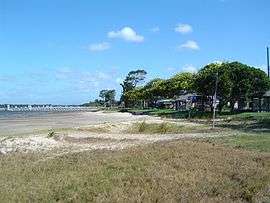
.jpg)
Populations are provided below for the Gold Coast (Southport/Coolangatta, South Coast, Gold Coast) and Albert entities. As Albert included the entire Logan City area prior to 1978, figures are only provided from the 1976 census.
| Year | Population (Gold Coast) |
Annual growth (%) |
Population (Albert) |
Annual growth (%) |
|---|---|---|---|---|
| 1933 | 6,046 | N/A | ||
| 1947 | 13,888 | 6.12 | ||
| 1954 | 19,807 | 5.20 | ||
| 1961 | 33,716 | 7.90 | ||
| 1966 | 49,481 | 7.97 | 6,437 | N/A |
| 1971 | 66,697 | 6.15 | 10,165 | 9.57 |
| 1976 | 87,510 | 5.58 | 24,268 | 19.01 |
| 1981 | 117,824 | 6.13 | 54,870 | 17.72 |
| 1986 | 130,304 | 2.03 | 92,766 | 11.07 |
| 1991 | 157,857 | 3.91 | 143,697 | 9.15 |
| Year | Population | Annual growth (%) |
|---|---|---|
| 1991 | 301,554 | 6.21 |
| 1996 | 375,175 | 4.47 |
| 2001 | 441,736 | 3.32 |
| 2006 | 507,876 | 2.83 |
| 2011 | 494,501 | Beenleigh left in deamalgamation |
| 2016 | 551,721 | 2.49 |
Demographics
| Selected historical census data for City of Gold Coast local government area | ||||||
|---|---|---|---|---|---|---|
| Census year | 2001[10] | 2006[11] | 2011[12] | 2016[13] | ||
| Population | Estimated residents on census night | 426,661 | 472,279 | 494,501 | 555,721 | |
| LGA rank in terms of size within Queensland | 2nd | |||||
| % of Queensland population | 11.9% | |||||
| % of Australian population | 2.27% | |||||
| Dwelling structure | ||||||
| Dwelling type | Separate house | 58.5% | ||||
| Semi-detached, terrace or townhouse | 16.0% | |||||
| Flat or apartment | 22.1% | |||||
Libraries
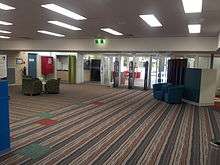
The first municipal library on the Gold Coast opened in the Southport Town Hall on 30 April 1958. Prior to this, a series of School of arts and private circulating libraries had supported the communities' and visitors' recreational and educational reading needs.[14]
The City of Gold Coast has 12 libraries at Broadbeach (at Mermaid Waters), Burleigh Heads, Burleigh Waters, Coolangatta, Elanora, Helensvale, Nerang, Palm Beach, Robina, Runaway Bay, Southport and Upper Coomera.[15] There is a special needs library within Nerang Library[16] and a Local Studies Library (on the first floor of Southport Library).[17] The council also operate a mobile library service.[15]
In 2018, the mobile library provides a fortnight service to Alberton, Ashmore, Benowa, Bonogin, Cedar Creek, Coomera, Currumbin Valley, Gilston, Jacobs Well, Mudgeeraba, Ormeau (4 visits), Paradise Point, Pimpama (3 visits), Tugun, Steiglitz, Tallebudgera Valley, and Woongoolba.[18] The Gold Coast City Library is a member of the Queensland Public Libraries Association.[19]
Key projects
- Gold Coast University Hospital
- Tugun Desalination Plant
- Raising of Hinze Dam
- Southport Broadwater Parklands
- Gold Coast Rapid Transit System
- Gold Coast Ferry Service
- Gold Coast Regional Botanic Gardens
- Evandale Cultural Precinct including a greenbridge from Evandale Parklands to Chevron Island
- Mermaid Waters Library
- Gold Coast Shoreline Management Plan
Notable personnel
Notable people who work for or who have worked for the City of Gold Coast include:
- Guillermo Capati, 1994 – 2017, managed the city's water and wastewater needs, long-term water planning and recycled water[20][21]
See also
- Gold Coast Art Centre
- Gold Coast City Art Gallery
- List of Gold Coast suburbs
References
- "3218.0 – Regional Population Growth, Australia, 2017–18: Population Estimates by Local Government Area (ASGS 2018), 2017 to 2018". Australian Bureau of Statistics. Australian Bureau of Statistics. 27 March 2019. Retrieved 25 October 2019. Estimated resident population, 30 June 2018.
- "SOUTHPORT A TOWN". Daily Standard (Brisbane, Qld. : 1912 – 1936). 13 April 1918. p. 7. Retrieved 17 January 2020.
- "External Boundaries of Local Authorities" (PDF). Electoral and Administrative Review Commission. Archived (PDF) from the original on 20 February 2014. Retrieved 3 February 2014.
- "2016 Gold Coast City Council – Councillor Election – Election Summary". results.ecq.qld.gov.au. Archived from the original on 20 March 2018. Retrieved 20 March 2018.
- "2012 Gold Coast City – Mayoral Election – Election Summary". results.ecq.qld.gov.au. Archived from the original on 1 April 2018. Retrieved 4 December 2017.
- "2016 Gold Coast City Council – Mayoral Election – Election Summary". results.ecq.qld.gov.au. Archived from the original on 21 March 2018. Retrieved 4 December 2017.
- Corporate services, Office of the CEO, Council Support. "Councillors and Divisions". goldcoast.qld.gov.au. Retrieved 11 May 2020.CS1 maint: multiple names: authors list (link)
- "2020 Local Government Elections: Saturday, 28 March 2020". Electoral Commission of Queensland. 2020. Archived from the original on 16 June 2020. Retrieved 16 June 2020.
- "2017 Queensland State Election Summary". 12 December 2017. Archived from the original on 9 December 2017. Retrieved 14 December 2017.
- Australian Bureau of Statistics (9 March 2006). "Gold Coast (C)". 2001 Census QuickStats. Retrieved 28 December 2019.
- Australian Bureau of Statistics (25 October 2007). "Gold Coast (C)". 2006 Census QuickStats. Retrieved 28 December 2019.
- Australian Bureau of Statistics (31 October 2012). "Gold COast(C)". 2011 Census QuickStats. Retrieved 28 December 2019.

- Australian Bureau of Statistics (27 June 2017). "Gold COast(C)". 2016 Census QuickStats. Retrieved 28 December 2019.

- "Public Libraries on the Gold Coast". Gold Coast Stories. Archived from the original on 8 March 2019. Retrieved 31 January 2019.
- "Libraries". City of Gold Coast. Archived from the original on 26 March 2017. Retrieved 22 March 2017.
- "Libraries". Special Needs Library. City of Gold Coast. Archived from the original on 23 March 2017. Retrieved 22 March 2017.
- "Libraries". Local Studies Library. City of Gold Coast. Archived from the original on 21 April 2017. Retrieved 22 March 2017.
- "Mobile Library 2018 timetable" (PDF). Gold Coast City Council. Archived from the original (PDF) on 30 January 2018. Retrieved 30 January 2018.
- Queensland Public Libraries Association: Membership Archived 14 January 2014 at the Wayback Machine. Retrieved 4 January 2014.
- "Australia Day 2013 Honours List". The Sydney Morning Herald. 25 January 2013. Archived from the original on 14 June 2018. Retrieved 9 April 2018.
- "Filipino awarded with Australian public service medal". The Philippine Star. Retrieved 9 April 2018.